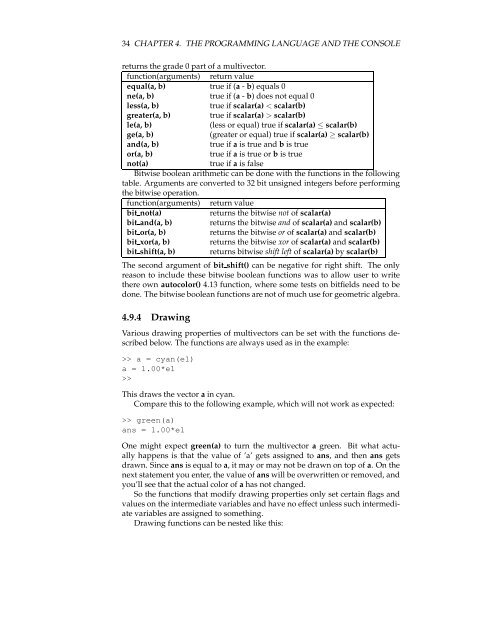GAViewer 0.43 manual (.pdf)
GAViewer 0.43 manual (.pdf)
GAViewer 0.43 manual (.pdf)
You also want an ePaper? Increase the reach of your titles
YUMPU automatically turns print PDFs into web optimized ePapers that Google loves.
34 CHAPTER 4. THE PROGRAMMING LANGUAGE AND THE CONSOLE<br />
returns the grade 0 part of a multivector.<br />
function(arguments) return value<br />
equal(a, b)<br />
true if (a - b)equals0<br />
ne(a, b) true if (a - b) does not equal 0<br />
less(a, b)<br />
true if scalar(a) < scalar(b)<br />
greater(a, b) true if scalar(a) > scalar(b)<br />
le(a, b)<br />
(less or equal) true if scalar(a) ≤ scalar(b)<br />
ge(a, b)<br />
(greater or equal) true if scalar(a) ≥ scalar(b)<br />
and(a, b)<br />
true if a is true and b is true<br />
or(a, b)<br />
true if a is true or b is true<br />
not(a)<br />
true if a is false<br />
Bitwise boolean arithmetic can be done with the functions in the following<br />
table. Arguments are converted to 32 bit unsigned integers before performing<br />
the bitwise operation.<br />
function(arguments) return value<br />
bit not(a)<br />
returns the bitwise not of scalar(a)<br />
bit and(a, b) returns the bitwise and of scalar(a) and scalar(b)<br />
bit or(a, b)<br />
returns the bitwise or of scalar(a) and scalar(b)<br />
bit xor(a, b) returns the bitwise xor of scalar(a) and scalar(b)<br />
bit shift(a, b) returns bitwise shift left of scalar(a) by scalar(b)<br />
The second argument of bit shift() can be negative for right shift. The only<br />
reason to include these bitwise boolean functions was to allow user to write<br />
there own autocolor() 4.13 function, where some tests on bitfields need to be<br />
done. The bitwise boolean functions are not of much use for geometric algebra.<br />
4.9.4 Drawing<br />
Various drawing properties of multivectors can be set with the functions described<br />
below. The functions are always used as in the example:<br />
>> a = cyan(e1)<br />
a = 1.00*e1<br />
>><br />
This draws the vector a in cyan.<br />
Compare this to the following example, which will not work as expected:<br />
>> green(a)<br />
ans = 1.00*e1<br />
One might expect green(a) to turn the multivector a green. Bit what actually<br />
happens is that the value of ’a’ gets assigned to ans, andthenans gets<br />
drawn. Since ans is equal to a, it may or may not be drawn on top of a. Onthe<br />
next statement you enter, the value of ans will be overwritten or removed, and<br />
you’ll see that the actual color of a has not changed.<br />
So the functions that modify drawing properties only set certain flags and<br />
values on the intermediate variables and have no effect unless such intermediate<br />
variables are assigned to something.<br />
Drawing functions can be nested like this:
















